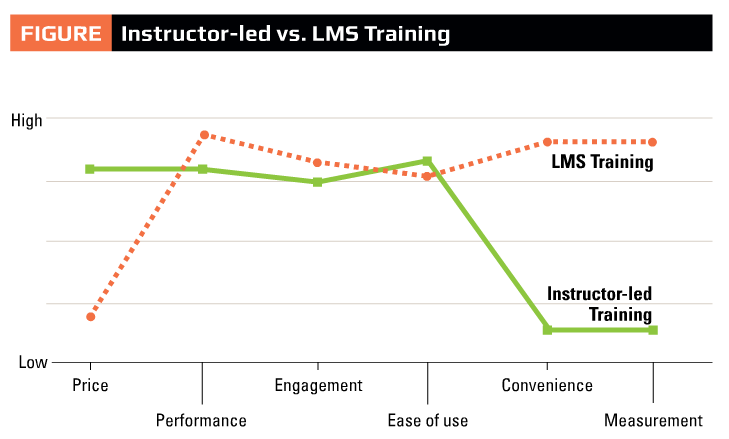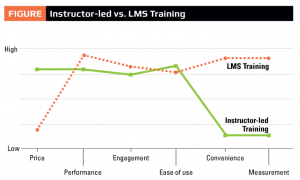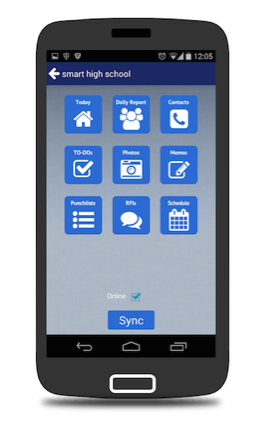The first stone tools were made and used by early humans nearly 2.5 million years ago. As man evolved, so did the tools, transforming from blunt objects to precision equipment capable of greater rates of productivity and improved craftsmanship.
These days, tools aren’t the only advancements helping us do our jobs. During the past 10 years, safety training and compliance have evolved into a Learning Management System (LMS). An LMS is a software application for the administration, documentation, tracking, reporting and delivery of training programs.
BENEFITS
To better demonstrate the strategic value of an LMS, let’s look at the competitive profile comparing instructor-led training to LMS training. In the figure, the horizontal axis of the competitive profile captures the range of factors on which LMS and instructor-led training solutions compete. There are six principle factors:
-
▪▪ PRICE: The cost to set up and deliver an employee training solution.
▪▪ PERFORMANCE: Training that goes beyond introducing knowledge and generates behavior change, driving improved individual, team and organizational performance.
▪▪ ENGAGEMENT: Instructionally sound, visually appealing and interactive training programs that engage individuals throughout the learning.
▪▪ EASE OF USE: Easy set up and maintenance of the training and delivery system.
▪▪ CONVENIENCE: Easy employee access to the training, anytime and anywhere. This includes the office, the job site or even at home. Management can access records from mobile workstations without having to be in the office.
▪▪ MEASUREMENT: Easy and cost-effective learner tracking, measurement and reporting.
The figure shows LMS and instructor-led training score high for Performance, Engagement and Ease of Use. However, instructor-led training, relatively speaking and largely due to its inherent lack of convenience, is expensive (in addition to paying the training company, think travel and/or time away from the job for the trainees) and, therefore, it gets a low score on Convenience and Price.
In addition, LMS allows the employer the opportunity to automate the training process, deliver offline training and ensure continued compliance. To automate training, the employer creates a list of trainings needed by job description. These lists are then used to create a learning plan. When the employer puts a new employee into the system, the LMS will automatically assign the training content via the job description. The employer then monitors the system to ensure the employee is completing his or her training.
If the employer chooses not to use automation to assign training inside of the LMS, he or she can manually assign training courses one at a time through the system. This may be done to reissue a training course because of a workplace incident.
DID YOU KNOW?
More than 40 percent of global
Fortune 500 companies are
using some form of a Learning
Management System.





Be the first to comment on "Upgrade to a Learning Management System"